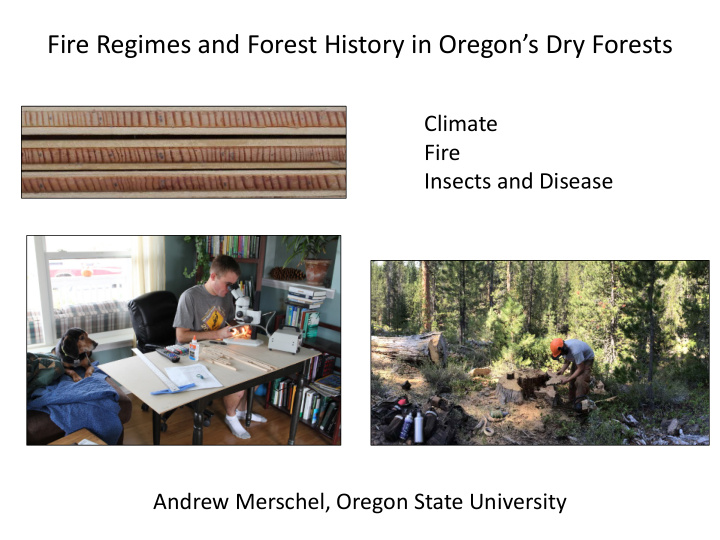



Fire Regimes and Forest History in Oregon’s Dry Forests Climate Fire Insects and Disease Andrew Merschel, Oregon State University
Reconstructing Historical Fire Regimes
Reconstructing Forest History Fire Tree Establishment
Land Use Changes in Mixed-Conifer Forests (Early 1900s) This image cannot currently be displayed. Selective Logging of Large Fire-Resistant Trees Heavy Grazing Fire Exclusion and Suppression Powell 2011
Dry Forest Tree Ring Fire and Forest Histories 2008
Dry Forest Tree Ring Fire and Forest Histories 2018
What was the historical structure, composition, and development history of Oregon’s Dry Forests? Persistent Ponderosa Pine
What was the historical structure, composition, and development history of Oregon’s Dry Forests? This image cannot currently be displayed. Recent Douglas-fir
What was the historical structure, composition, and development history of Oregon’s Dry Forests? This image cannot currently be displayed. Recent Grand Fir
What was the historical structure, composition, and development history of Oregon’s Dry Forests? Persistent Shade Tolerant
Variable Response to Land Use Change
Response to Land Use Change Varies with Environment S o l a Persistent Ponderosa r Pine R a d i a t i o n Recent Grand Fir Recent Douglas-fir Persistent Shade Tolerant Precipitation and Elevation Average Maximum Temperature
Landscape Fire Reconstruction Across Forest Types Precipitation (in) Annual August 45 1 20 0.5
Historical Fire Size and Frequency Fire Rotation 19 years
Variation in Frequency Among Forest Types Interval (years) 30 25 20 15 10 n = 13 n = 17 n = 22 n = 17 n = 13 Persistent Persistent Recent Persistent Persisten Ponderosa Ponderosa Grand Fir Shade Shade Pine with Tolerant Tolerant Lodgepole with Lodgepol
Take Home Messages Historical fire kept density low across a broad range of forest types. In the absence of fire, there has been far greater change in moister and more productive settings. Historically, fire occurred far more frequently and fire perimeters were much larger. Low severity surface fire was the dominant fire effect in very different forest types from ponderosa pine to mixed-conifer. Infrequent, high severity fire occurred, but it was quite limited in spatial extent.
Variable Response to Land Use Change Fire Exclusion
The Study of Tree Rings (Dendrochronology) Climate Fire Insects and Disease
Ponderosa Pine Recent Douglas-fir Recent Grand Fir Persistent Shade Tolerant
Response to Land Use Change Varies with Environment HOT COLD Persistent DRY WET Ponderosa Pine SLOPED SLOPED Recent Grand Fir Persistent Shade Tolerant TOPOGRAPHY Persistent Persistent Shade Ponderosa Tolerant w Lodgepole w Lodgepole HOT COLD DRY WET FLAT FLAT Lodgepole CLIMATE
Recommend
More recommend